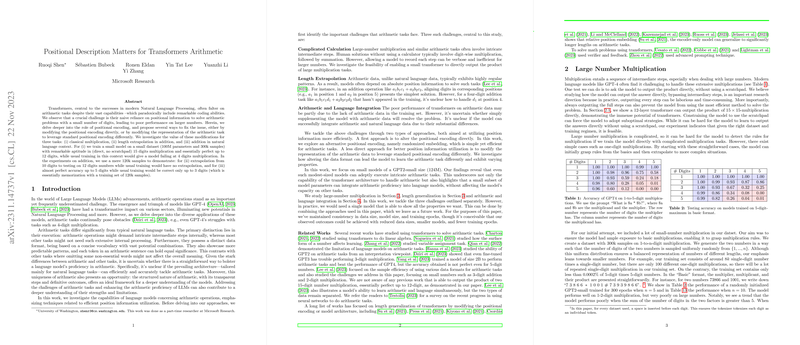The central focus of "Positional Description Matters for Transformers Arithmetic" (Shen et al., 2023 ) is the impact of positional encoding on the performance of Transformers in arithmetic tasks. This paper identifies that standard positional encodings significantly limit the ability of Transformer models to handle arithmetic problems as the number of digits increases.
Key Points on Positional Encoding in Arithmetic Tasks
- Positional Challenge: Transformers struggle with arithmetic tasks, particularly with large numbers, due to their naive reliance on positional encoding. Standard training approaches fail to generalize beyond a small number of digits, such as 4-digit multiplication, whereas optimal modifications can enable accurate multiplication of up to 12-15 digits.
- Proposed Modifications:
The paper suggests two potential solutions: - Modifying Positional Encoding: Adjusting how positional information is integrated into the model. - Altered Task Representation: Redefining how arithmetic tasks are encoded to exploit the positional encoding more effectively, for example, through different surface forms or intermediate step encoding.
- Experimental Results:
- Multiplication: With minimal data, a small model achieved remarkable accuracy in 15-digit multiplication, while traditional methods only managed 4 digits.
- Addition Tasks: Experiments involving digit length extrapolation showed significant improvements, demonstrating the model's capability to generalize to unseen digit lengths.
Additional Insights from Related Works
- Rotary Position Embedding (RoPE) (Su et al., 2021 ): Introduces a rotation matrix-based method for positional encoding, showing enhanced performance in long text classification. Though not explicitly arithmetic-focused, it offers a method to handle positional information flexibly, which might benefit arithmetic tasks indirectly.
- Conditional Positional Encoding (CPE) (Chu et al., 2021 ): Dynamically generates encodings based on input neighborhood, improving generalization and translation invariance. This adaptability might help Transformers tackle larger arithmetic problems by providing a more context-aware positional understanding.
- Surface Form Representation (Nogueira et al., 2021 ): Demonstrates the influence of number representation on arithmetic task performance, highlighting that different encodings (position tokens) aid in learning addition and subtraction tasks efficiently.
- Length Generalization Challenges (Kazemnejad et al., 2023 , Lee et al., 2023 ): Studies on length generalization show that typical positional encodings like ALiBi, Rotary, and Absolute Position Embedding (APE) are not well-suited for longer sequences. They suggest that alternative encoding methodologies or even no explicit positional encoding might offer better results for arithmetic extrapolation tasks.
Conclusion
Positional encoding is crucial for the effective performance of Transformers on arithmetic tasks. The paper "Positional Description Matters for Transformers Arithmetic" highlights significant improvements by adjusting positional encodings and task representation. Insights from related research suggest various enhancements to traditional positional encoding methods that could further help Transformers generalize arithmetic operations over larger numbers.
